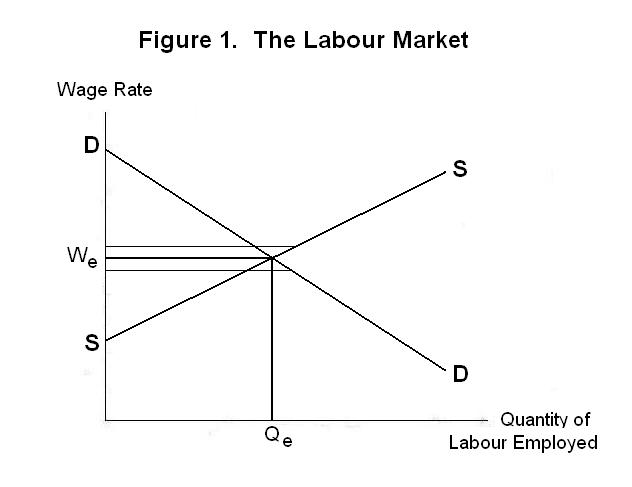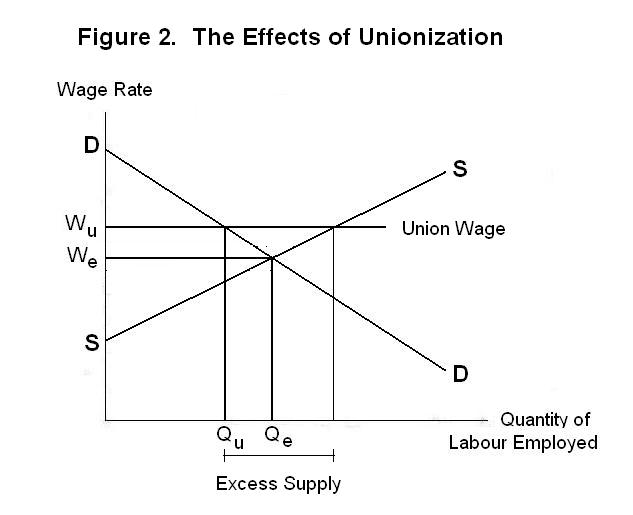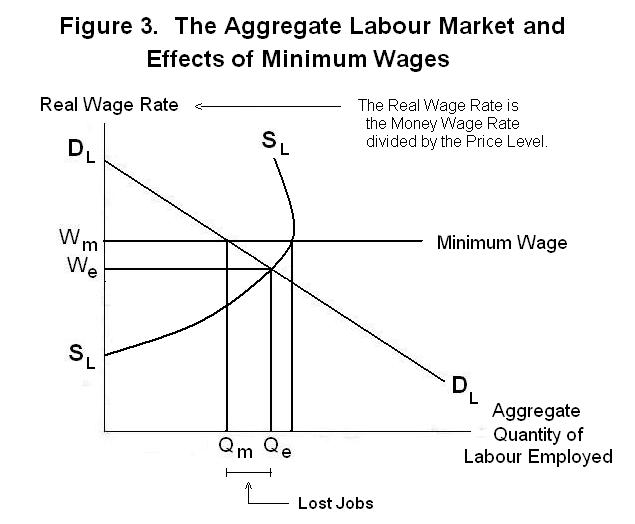
A basic principle of economics is the notion that the price
or value of anything, be it a commodity like bananas, an asset
like money balances, or a resource like labour, is determined
by the demand and supply for it. The supply and demand for labour
in the production of a particular commodity is modeled in Figure 1.
The supply curve is given by SS and the demand curve
by DD. The horizontal axis gives the quantity of labour employed
and the vertical axis the nominal wage per unit of labour under the assumption
that the general price level is constant.
In this module we explain the reasons why there might be
unemployment in the economy. Unemployment is a situation where
people who are willing to work at or below prevailing wage rates
cannot find employment. It is thus natural to begin by asking the
question: What determines market wage rates?

The demand for labour will be negatively sloped in all types of production for two reasons. First, a rise in the wage rate increases the costs of firms producing the commodity, forcing them to raise their selling prices. As the price of the product rises consumers will buy less of it and less output will be produced and sold. This means that less labour will be used. Second, since a rise in wages makes labour more expensive relative to capital, firms will substitute capital for labour. This means that less labour will be used to produce whatever output the firms in the industry sell.
If the wage is free to adjust in response to market forces it will move to We, where the demand for labour equals the supply. When the wage is above We, more labour will be presented for employment than firms in the industry can profitably hire. It will pay workers to lower their wages to obtain employment in the industry. And when the wage is below We, firms will find it profitable to hire more labour than is presenting itself for employment. They will offer a higher wage to obtain additional workers.
Unemployment can only result in an industry if the wage is above the market equilibrium and some institutional force keeps it from being bid down---for example, a union-industry agreement might fix the wage at Wu, in Figure 2. This will mean that workers who are willing to work in the industry at a wage above We, but below Wu, will not find employment there. This does not mean, of course, that there will be unemployment in the economy as a whole because the workers who are displaced from this industry will simply bid wages down and find employment in the non-unionized sector.

Under what circumstances will there be unemployment in the economy as a whole? To think about this question we must think in terms of an aggregate demand and aggregate supply of labour---that is, in terms of the demand and supply of labour in the economy as a whole. This is modeled in Figure 3 where we put the real wage rate---that is, the nominal wage rate divided by the price level---on the vertical axis. The aggregate demand for labour will be negatively related to the real wage rate for the same reason that the demand curve for labour in any industry is negatively sloped---at lower wages firms will substitute the less expensive labour for capital and their costs will be lower so they can produce and sell more output.

The aggregate supply curve for labour, however, may not be positively sloped throughout its range. The reason is the wealth effect of increased wages. At low wage levels, higher wages induce people to work more because they make leisure more costly in terms of the income that must be given up at the margin to obtain it. Workers substitute income for leisure. At higher wage and income levels, however, the increase in income that can be obtained by working more in response to a higher wage typically becomes less valuable than the leisure that is foregone. A wage level will be reached beyond which workers will do less work for higher wages because they can maintain the same satisfaction as before, or even increase it, with less work effort.
As people become wealthier they take more leisure and do less work. Thus, an increase in wages beyond some level, by further raising wealth, increases desired leisure by more than increased opportunity cost of leisure reduces it. Workers thus work less as wages rise beyond some point, and the SS curve bends backward as shown in Figure 3. The wealth effect of higher wages on leisure offsets the substitution effect. This explains why the enormous growth of per capita income in western countries during the last century has been accompanied by substantial declines in hours worked per week.
Figure 3 shows clearly the effect of an institutionally fixed minimum wage, whether imposed by the government or by union power, on aggregate employment in the economy. Anyone whose marginal product of labour is less than the minimum real wage Wm will not find employment in the economy. Unlike the case where wages are fixed in some sector of the economy, the labour displaced here by the minimum wage has nowhere to go to bid down wages to obtain employment.
Industrialized economies like those of Canada and the United States are less than one-third unionized. Minimum wages are in force but they are quite low and would displace only the most unskilled workers from employment. Why then do we observe substantial unemployment in these economies from time to time? What is it that is keeping wages too high, and preventing workers from bidding them down? This is the subject of our next three Topics. Before addressing it, however, there are two preliminary issues that must be dealt with.
First, we must recognize that even under the best conditions there will always be some amount of unemployment. Some people will be in the process of moving between jobs. Technological change inevitably leads to job losses in some areas of the economy and new jobs in other areas. It takes time for those displaced to relocate. Some degree of unemployment in the economy is thus inevitable and is not a signal that people who want jobs at current wages cannot find them. The normal level of this frictional unemployment is termed the natural rate of unemployment. Frictional unemployment does not appear in Figure 3. The supply curve SS represents only the work offered at various wages by those workers who have found desired employment---it reveals their response at various wages rates when they are fully informed about alternative opportunities. Workers in the process of becoming informed are not part of the analysis.
The fact that frictional unemployment does not appear in Figure 3 and play a role in the determination of the equilibrium wage rate in the economy highlights the second issue that we must address. Supply and demand diagrams, by construction, assume that every buyer decides what and when to buy at prices he/she takes as given, and every seller decides how much and when to sell at prices that are also taken as given. In other words, individual buyers and sellers have no influence on the market price. Market prices are determined by all buyers and sellers together.
But this raises a fundamental question. What is the process by which prices change? If every buyer and seller takes the price as given, there is no one in the market that performs the act of actually changing the price! The supply and demand diagram assumes that prices get bid up and down while every market participant takes them as given. Indeed, it is as though there were an auctioneer in the background calling out prices to which suppliers and demanders respond. Such an auction mechanism can, in fact, be invoked to provide a rigorous basis for the analysis.
But there are very few actual markets---mostly markets for stocks and bonds and commodities like wheat, gold, cattle and pork bellies---in which auction mechanisms for setting prices exist. These are markets for commodities whose quantities can be precisely defined and measured. Labour is not such a commodity. For most supply and demand analysis, including labour market analysis, the precise mechanism through which price changes occur is unimportant---all that is required is that prices somehow adjust to equalize demand and supply.
When it comes to understanding the process by which workers find or fail to find jobs, however, the institutional details of wage adjustment become important. Essentially, the assumption that labour is a homogeneous commodity for which a unique market price exists must be abandoned and workers must be viewed as imperfect competitors, each selling a unique product to firms who are also imperfect competitors in labour markets, each offering a variety of unique jobs. The next Topic presents an auction theory of why and how unemployment can deviate from its natural level. It will show how far we can get using traditional demand and supply analysis with homogeneous labour but imperfect information, making no further assumption of labour-market imperfections. The subsequent Topics present a search and a contract theory, both of which abandon the homogeneity-of-labour assumption and introduce refinements of standard supply-and-demand theory.
But first, we need a test. As always, think up your own answers before looking at the ones provided.
Question 1
Question 2
Question 3
Choose Another Topic in the Lesson